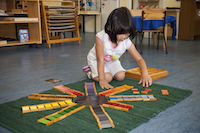Site-Wide Glossary
Site-Wide Glossary
Special | A | B | C | D | E | F | G | H | I | J | K | L | M | N | O | P | Q | R | S | T | U | V | W | X | Y | Z | ALL
P |
|---|
S |
|---|
Sensitive periodsA term used by Montessori to describe a critical time during human development when young children are neurologically ready to learn a specific skill or ability. During this time, an individual becomes particularly sensitive to stimuli that promote the specific developmental acquisition. Montessori observed that during a sensitive period, children are intensely interested in tasks that are related to the particular area of development, sometimes to the exclusion of everything else. For example, children in the sensitive period for numbers (4- 4 1/2 years) will be drawn to work with the Maths Materials. When children choose such activities they become absorbed in deep concentration. | ||
Sensorial A core learning area in a Montessori Prepared Environment for young children (from birth to 6 years of age). It includes activities that develop and refine the 5 senses--seeing, hearing, touching, tasting, and smelling. The Montessori Materials used in the sensorial area materials were created to help young children in the process of creating and organising their intelligence. Each material isolates a quality found in the world (such as colour, size, shape, etc.) to allow children to focus their attention on this one aspect. | |
Skill outcomesA type of learning outcome specific to a Montessori Professional Learning Series course. It is a specific list of what students should be able to do by the end of the course or module. | ||
Summative assessmentOne of two types of assessments. These are assessment activities designed to formally evaluate student learning. In Montessori Professional Learning Series courses, students enrolled in the Participation Stream are not required to complete the summative assessment activities. Students enrolled in the Certification Stream are required to successfully complete all summative assessment activities to be awarded a Certificate of Attainment. | ||
T |
|---|
The 3-period lessonA 3-step technique used by Montessori Teachers for presenting new information to a child. In the first--the introduction or naming period--the teacher demonstrates what "this is.” (The teacher might say "This is a mountain” while pointing to it on a 3-dimensional map.) In the second--the association or recognition period--the teacher asks the child to "show” what was just identified ("Show me the mountain”). Finally, in the recall period, the teacher asks the child to name the object or area. Moving from new information to passive recall to active identification reinforces the child's learning and demonstrates her mastery. | |
W |
|---|
Work
She observed that young children learn best when given the opportunity to engage in "hands-on” activities of their own choosing, as opposed to following the instructions of an adult. What Montessori preferred to call the "work of childhood”, some educationalists call "play”. What is certain is that children are serious when engaged in the kind of activity that meets developmental needs and, given freedom and time, will choose purposeful activities over frivolous make-believe ones. [fa-link] The Five Characteristics of Play--And of Montessori Work | |

 Montessori used this term to describe the purposeful activity of children
Montessori used this term to describe the purposeful activity of children